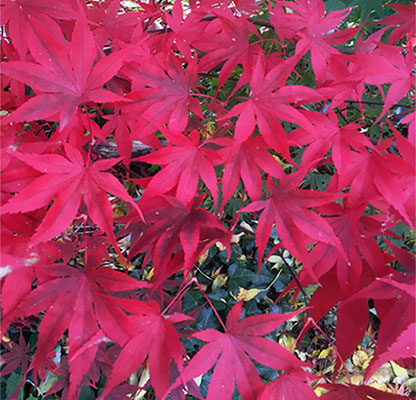Blood and fire – life giving,
but filled with awe.
Blood is something we often now avoid the
sight of, but I think it is the very basic
human fear of spilling that precious
crimson which gives the colour red it’s
symbolic power –both positive and
negative, attracting and repelling
depending on the context.
No doubt the power of red has it’s roots
in the earliest days of humankind when a
wound was more likely to be fatal, and
everyone knew that when blood departs then
so does life. The Old Testament puts it
like that ‘The life is in the blood’ – and
though we could debate how scientifically
accurate that is, the meaning of ‘spilt
blood’, the taking or giving of a life,
remains. And so red becomes the colour of
life and death at the same time, and the
colour of sacrifice and martyrdom as well
as the colour of the life-giving Spirit –
at least in the seasonal dressing of
liturgical churches.
Why is blood
red?
The chemistry of our blood has birthed a
symbolism with transcends culture and
language and history; Science has revealed
the mystery and the mechanism behind the
importance of blood - and in particular
it’s redness - for sustaining life
Haemoglobin, that amazing catalyst
molecule which welcomes and cradles atoms
of oxygen in its fingers and carries the
energy-element to where ever in our bodies
it is needed, then gives it up freely. It
gives up also the shining scarlet hue
created by their bonding, the blood
returning, dulled to a dark wine, back to
the lungs and ready to ferry more.
We could learn from that parable - how to
be carriers of the breath of life to
others in a delivery service which lights
us up as we carry the gift, but which must
be given away so we can take more. We
can't keep it to ourselves or the body
will die.
There is perhaps another parable in what
happens with Carbon monoxide poisoning
where the gas bonds preferentially to the
haemoglobin, blocking the places where
oxygen would be carried. Worse, it sticks
200 times more strongly than the oxygen
and is not easily given up. If we fill our
lives with the wrong things, more
attractive and more 'sticky', then we
don't have space for the 'oxygen', or the
ability to fulfill our calling to carry
life to where it is needed. The
'carboxyhaemaglobin' formed when
carbon monoxide gets in the bloodstream
makes it 'cherry red' but it remains in
the veins as well as the arteries,
refusing to ‘give up’ the poison gas and
so the victim may look flushed – when in
fact they are starved of oxygen.
Do we carry things in our lives
counterfeit things which ‘stick’ and
prevent us from living out our
calling? How might we lay aside the
attractive but fake before they displace
what is authentic and life-giving?
Hebrew 12.1-2
Let us also lay aside every weight and
the sin that clings so closely, and let
us run with perseverance the race that
is set before us,2looking to Jesus the
pioneer and perfector of our faith, who
for the sake of the joy that was set
before him endured the cross,
disregarding its shame, and has taken
his seat at the right hand of the throne
of God.
The blood of
Christ
Jesus’ sacrificial life and death was a
constant ‘giving up’ for the good of
others. Interestingly, the wine of the
Eucharist, is a colour closest to that of
venous blood which has given up it’s
oxygen for the good of the body. For
Christians, the blood of Jesus, shed for
us, is the most awesome symbolic meaning
in the story of the colour red. He shared
our humanity – our flesh and blood –
giving it up as the total offering of
himself. In Russian icons, the colour red
represents humanity, and Jesus is usually
depicted wearing red but with a blue cloak
showing the union of his two natures.
‘Veiled in flesh the Godhead see’ (Charles
Wesley, from ‘Hark the Herald angels
sing’)
Most of us don’t see much real blood in
our daily sanitized lives, though
ironically, the amount of graphic
bloodshed in films and TV has increased to
the point where it may cease to
shock.
The power of red blood in the ancient
world and the worship of the temple needs
to be appreciated in order to enter in to
its meaning and allow the imagery of the
Bible to hit home. We may need the
strength this brings in the days ahead.
It may seem illogical to us that a garment
washed in blood can come out white!!
(though I liken it to a ‘mud-pack’ where
the clay draws out impurities in the skin
leaving the face cleaner than ever
before). ‘These are they who have come out
of the great ordeal; they have washed
their robes and made them white in the
blood of the Lamb. (Revelation 7.14)
There is probably more that can be said
about the colour red but I’ll leave you
with two pictures.
The colours of autumn leaves in my
Japanese Maple ‘Bloodgood’ are the result
of nutrients being withdrawn; a reminder
that there is glory in the natural cycling
of things, life and death, and rebirth.
Acer
palmatum ‘Bloodgood’
And finally, something seasonal – the
traditional English folk Carol turns every
part of the Holly plant into a
symbol. ‘The holly bears a berry as
red as any blood. And Mary bore sweet
Jesus Christ for to do us sinners good.’
May you be blessed by his presence in all
the signs and symbols of Christmas this
year.
Ros Yates

